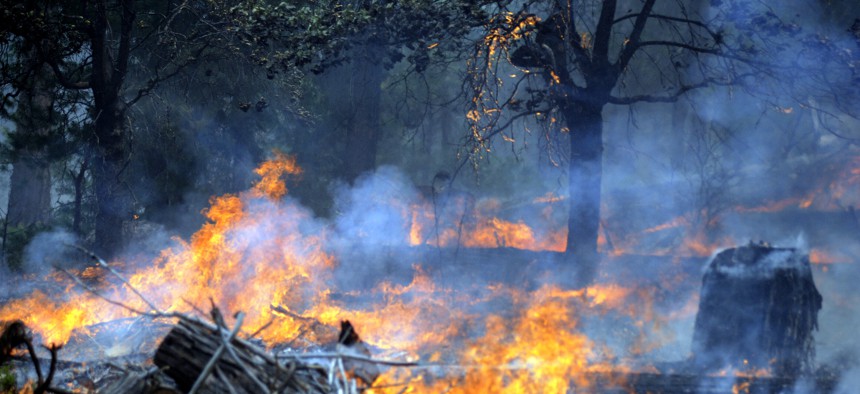Report: Smarter Wildfire Fighting Demands Better Data Quality and Sharing

Washburn Fire burning in Yosemite National Park forced the closure of the South Gate entrance Yosemite South Gate, CA, United States on July 11, 2022. Neal Waters/Anadolu Agency via Getty Images
The President’s Council of Advisors on Science and Technology issued a framework to help guide emerging tech implementation into wildfire control.
Increased data collection and interoperability are critical to helping U.S. firefighters combat severe wildfires, according to a White House council, which also called for modeling devices and specialized management to help support more coordinated efforts to prevent and mitigate wildfire disasters.
Released in a report last week, the President’s Council of Advisors on Science and Technology developed five recommendations to better integrate emerging technologies into government firefighting operations amid the continued prevalence of large scale wildfires.
“The technology revolution that has occurred over the last 25 years and benefitted nearly all aspects of American life should be leveraged to help wildland firefighters,” the report reads. “On the whole, federal agencies that have been tasked with managing wildfires have not had the opportunity to take full advantage of the possibilities that technology can offer to wildland firefighting safety and effectiveness.”
PCAST authors highlighted the importance of updated data sharing practices in wildfire response. Following the input of industry experts, one recommendation advocated for the need to use satellite data to better train firefighters in how exactly a wildfire grows and moves.
As these data sources include satellite imagery, with PCAST asking agencies like the National Oceanic and Atmospheric Administration and National Aeronautics and Space Administration to coordinate archival data sharing with officials at the Department of Defense for further dissemination.
Archival data from several conditions during fire events, namely topography, fuel loads, vegetation, weather and soil moisture, will then be used to create or further improve predictive wildfire modeling tools and make more accurate forecasts.
Consistent with other federal pushes for modernization, PCAST recommends partnerships between public entities and the private sector and academia.
“We can dramatically accelerate progress toward predictive wildfire modeling tools by engaging the broader community of researchers—in national labs, universities, and in the private sector—with expertise in AI, atmospheric science, remote sensing, advanced computational methods and other disciplines central to our understanding of wildfires,” the report says.
In addition to advanced data sharing, one recommendation calls for the establishment of a joint-agency executive office featuring Cabinet-delegated authorities to formally develop and implement a science and technology strategy tailored for effective wildfire fighting.
The Joint Office would helm the further application of other technologies, like drones and robotics, to be incorporated into modern wildfire management. These technologies would be autonomous and ideally analyze and process data to detect and suppress potentially catastrophic wildfire situations.
“The technological advances spurred by presidential action on these recommendations can make wildland firefighting safer and more effective, while also addressing growing shortages of firefighting resources,” the report concludes.
NEXT STORY: GSA Seeks Commercial Procurement Data Solution



